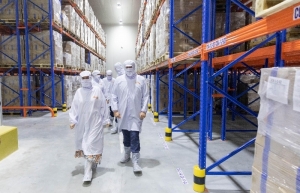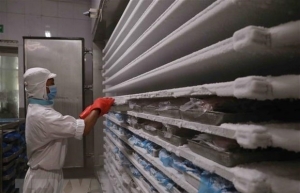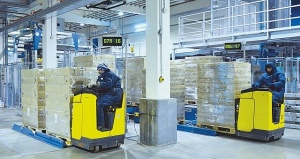Cold storage supply remains behind requirements
 |
| Cold storage supply remains behind requirements, illustration photo/ Source: freepik.com |
The country’s cold storage industry is expected to reach a value of $295 million by 2025, with an annual growth rate of 12 percentage points, according to Savills Vietnam.
At the end of August, Hau Giang Cold Storage Logistic Co., Ltd. started construction on its first outsourcing cold storage project in the same province.
The scheme includes six cold storages equivalent to a capacity of 88,000 tonnes.
With an estimated investment of around $21.7 million, the project will use modern technology from the EU and applying digital management. It is scheduled to be ready for operations by 2027.
A Savills Vietnam report released in August shows that, although it only accounts for 11.4 per cent of the total number of transactions in the industrial real estate segment, the cold storage real estate market recorded an annual growth rate of nearly 30 per cent from 2017 to 2022, far exceeding other types in the market.
The report shows that the fresh food industry revenue in the country increased by 6.3 per cent annually in 2020-2022, from $40.4 billion to $45.7 billion.
In addition, the e-commerce market also witnessed a significant growth rate, reaching 21.5 per cent in 2017-2022, promoting the expansion of all supporting services.
As a result, the online food delivery industry also recorded a rapid growth rate, reaching an increase of 5.5 per cent in 2020-2022.
The strong demand for fresh food amid booming e-commerce is the main driving force for the development of the cold storage market. However, the market in this country is still developing and small in scale, with just over 40 projects and concentrated in a few large cities only.
The majority of cold storage supply is concentrated in Ho Chi Minh City and neighbouring provinces such as Binh Duong, Long An, and Dong Nai, with a total area accounting for 87 per cent of the total supply in the country.
In the northern market, Hanoi, and Bac Ninh and Hung Yen provinces have also recorded a significant increase in supply, but are still limited in relation to the south.
Truong Dinh Hoe, general secretary of the Vietnam Association of Seafood Exporters and Producers (VASEP), acknowledged that Vietnam was seriously lacking in cold storage facilities.
“Cold storage is not only a necessary condition for businesses to purchase all the shrimp and fish raw materials produced by farmers, but also a key link to help businesses create a large source of goods, meeting export contracts when market demand arises,” Hoe said.
The domestic market also needs cold storage to distribute food that needs to be refrigerated and this need is increasing as modern retail develops, Hoe added.
“Current seafood processing factories also have on-site cold storage, but the capacity is small, only meeting part of the demand, and the rest must be outsourced. If the storage capacity is larger, businesses can buy more raw materials from farmers and have better output,” Hoe acknowledged.
The VASEP has proposed that the State Bank of Vietnam offer zero interest rates for the first two years, and reduce interest rates by half over the next four years for long-term loans invested into building cold storage with a capacity of 5,000 pallets or more.
Thomas Rooney, senior manager of Industrial Services at Savills Hanoi, said that cold storage rental prices in different markets were very diverse. Ho Chi Minh City has a rental price of about $50 per tonne each month, nearly twice as high compared to northern regions, due to better facilities and many other value-added services.
“The market in the south has recorded more dynamic development due to greater demand for food, seafood, and retail products,” Rooney said. “Change in consumer habits will be the main driving force driving to develop the cold storage and logistics services segment in the long term.”
The current supply of new cold storage mainly comes from domestic enterprises. Some typical units include An Viet Solution and Technology Co., Ltd., Hung Vuong JSC, and ABA Cooltrans.
Foreign businesses such as Lineage Logistics, SK Logistics and Lotte Logistics are also actively investing in their own storage systems in the Vietnamese market.
However, supply remains behind the demand. In the medium and long term, infrastructure development is the key to increasing cold chain supply, including specialised logistics centres and multimodal connections, Rooney added.
 | Andros opens cold storage facility in Tien Giang French fruit transformation company Andros, better known for its famous jam Bonne Maman, has opened its biggest cold storage facility in Vietnam in Go Cong town, Tien Giang province. |
 | Investors eager to boost cold storage The demand for cold storage is increasing thanks to the growth of agriculture and seafood, which is boosting investment trends in the market. |
 | Foreign companies ramp up interest in Vietnam's cold storage market On August 11, Lineage Logistics, a United States-based international cold chain solutions provider, announced its expansion in Vietnam through a joint venture with Hanoi-based, cold-storage warehouse operator SK. |
What the stars mean:
★ Poor ★ ★ Promising ★★★ Good ★★★★ Very good ★★★★★ Exceptional
 Tag:
Tag:
Related Contents
Latest News
More News
- PM sets January deadline for high-speed rail consultant (January 06, 2026 | 08:40)
- New decree spurs on PPP implementation (December 31, 2025 | 19:01)
- Global alliance develops $1 billion AI data centre network in Vietnam (December 30, 2025 | 10:08)
- Standing out in the Chinese outbound investment wave (December 29, 2025 | 10:29)
- Bright spots obvious in foreign investment mission (December 29, 2025 | 09:00)
- Ho Chi Minh City hits $8.37 billion in FDI (December 29, 2025 | 08:28)
- Vietnam and UK cooperation backs finance talent for IFCs (December 27, 2025 | 16:31)
- Global partnerships key to Vietnam’s IFC development (December 26, 2025 | 16:18)
- Vingroup pulls out of bid to invest in North-South high-speed railway (December 26, 2025 | 11:42)
- Strengthening supply chains through trade promotions and customs reform (December 24, 2025 | 14:00)




















 Mobile Version
Mobile Version